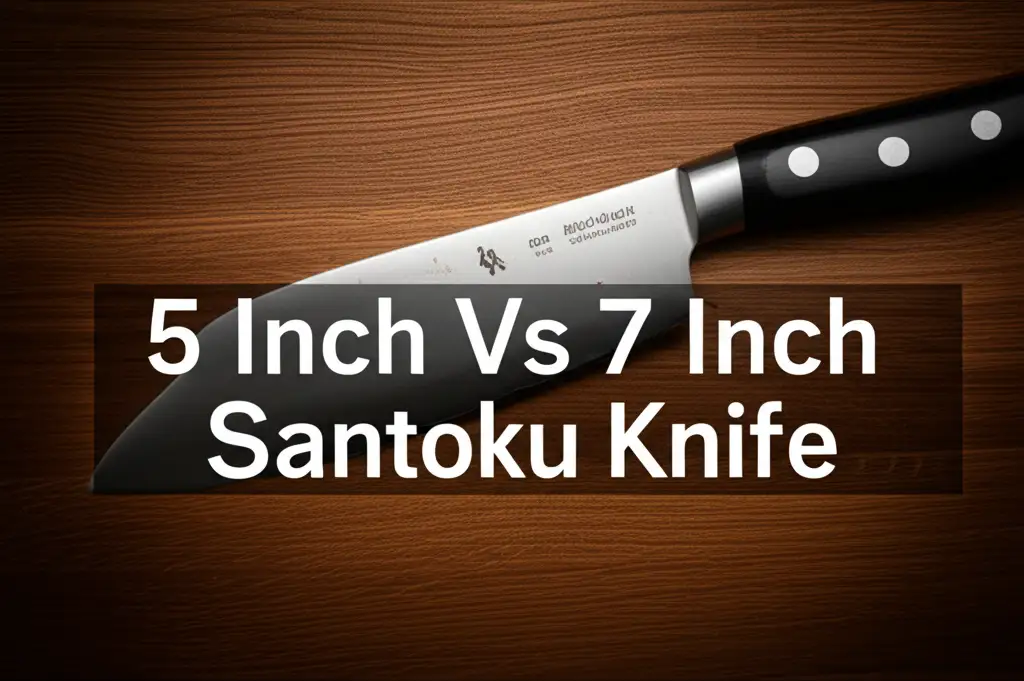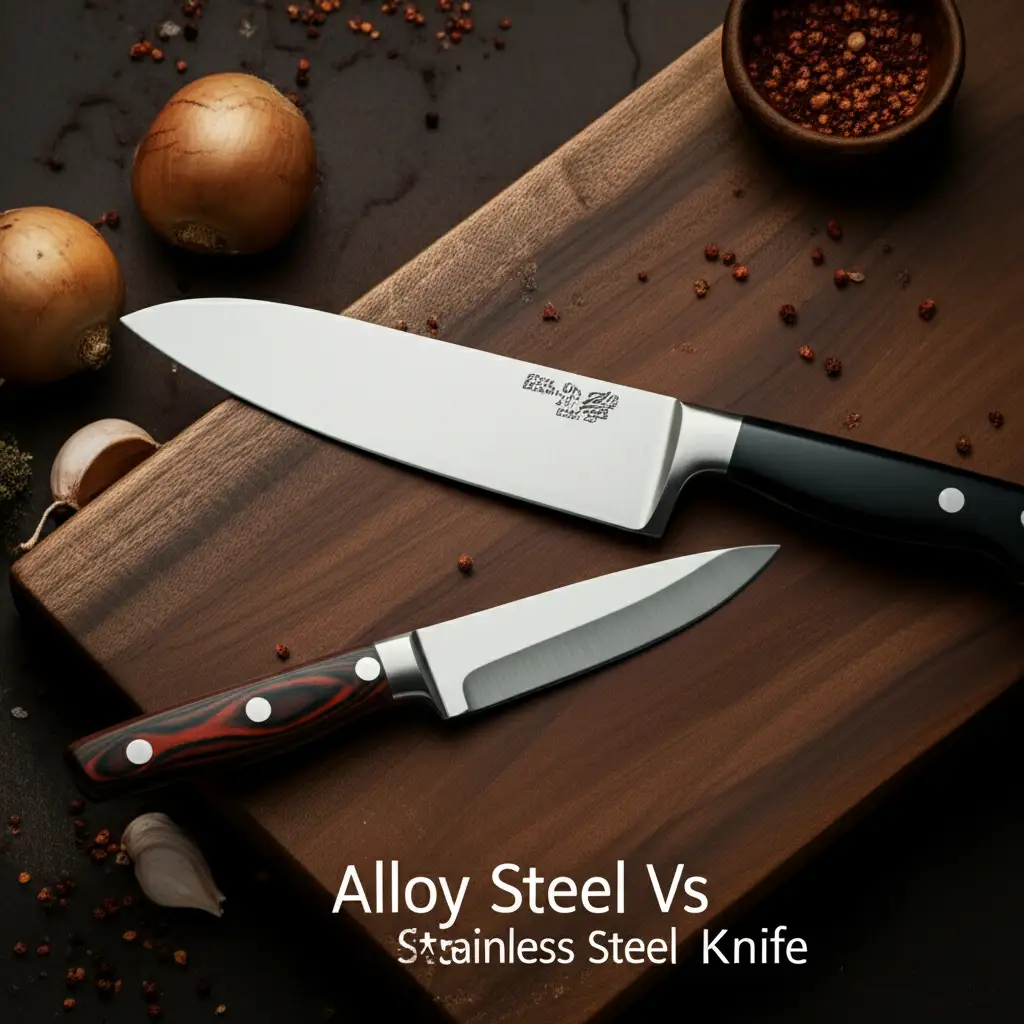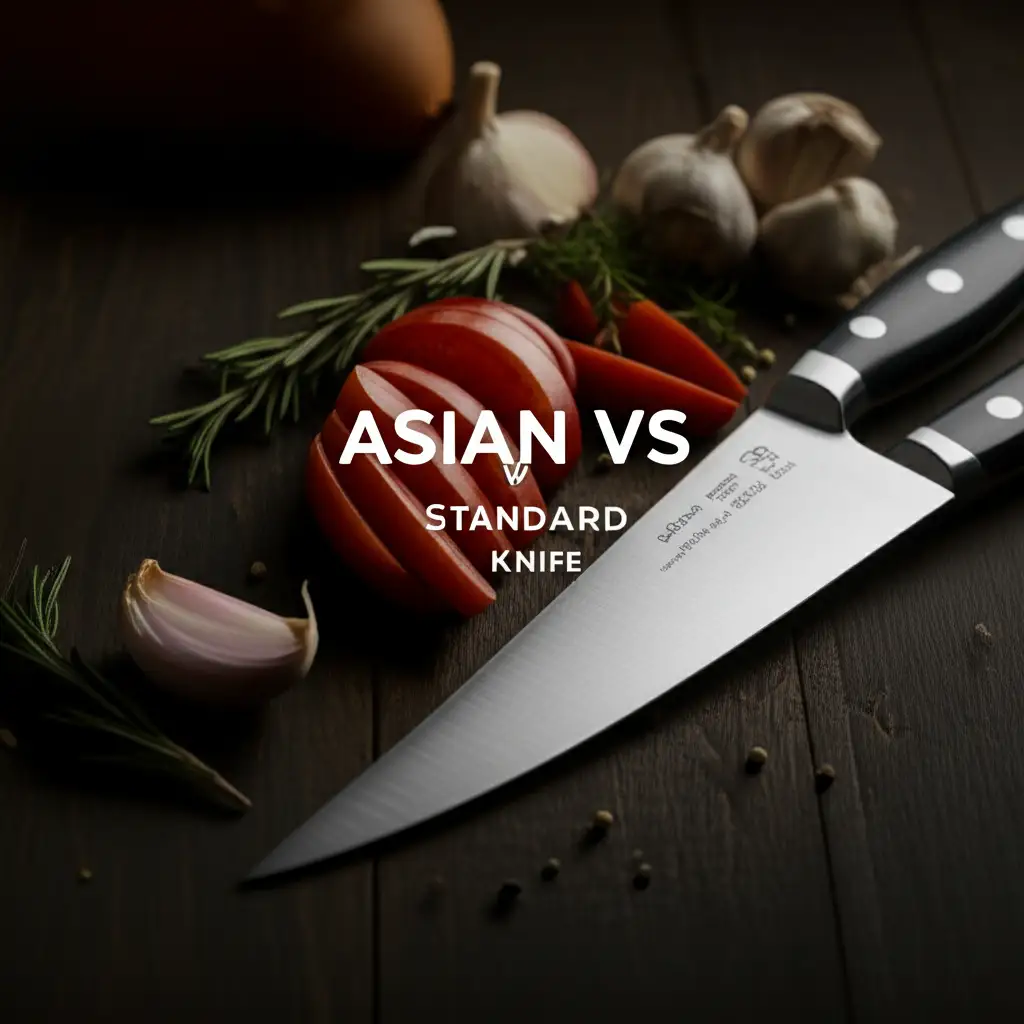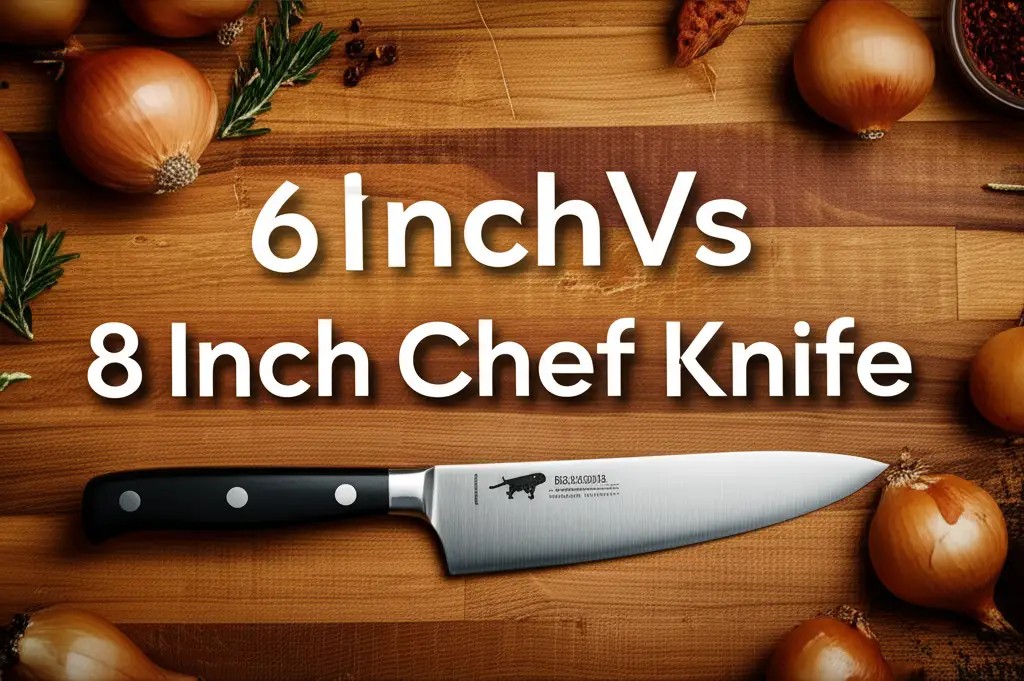· Elira Thomsen · Kitchen Knives · 17 min read
8 Vs 10 Inch Chef Knife
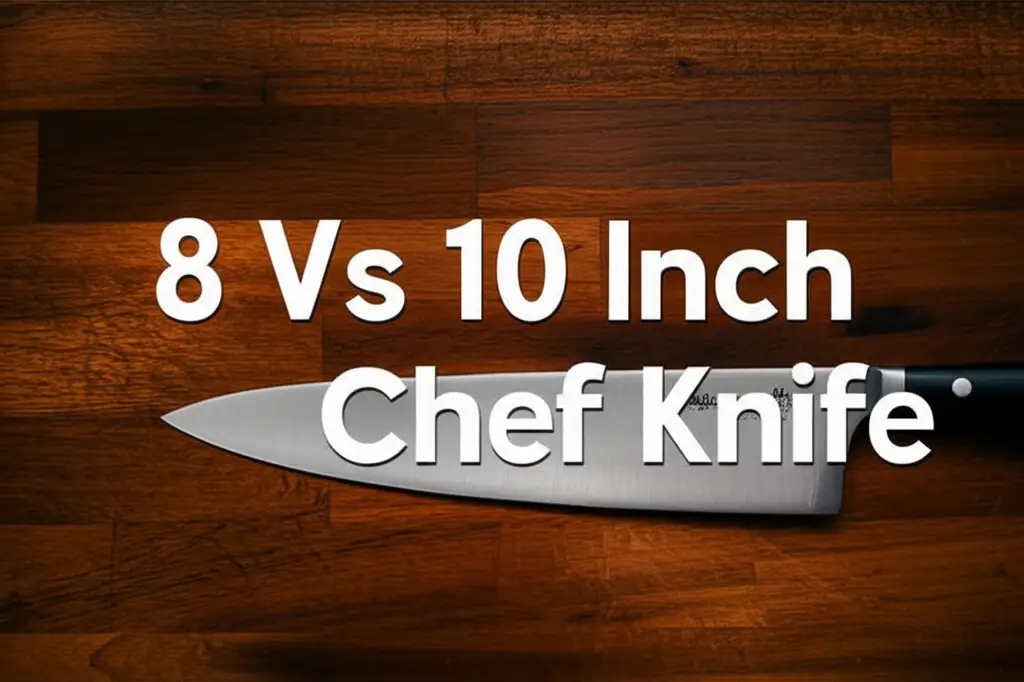
8 Vs 10 Inch Chef Knife: Which Blade Suits Your Kitchen?
Choosing the right chef knife feels like a big decision for any cook. You stand in the store, looking at different sizes, wondering which one will feel best in your hand. The 8 Vs 10 inch chef knife debate is common. People often ask which size offers the most utility. This article helps you understand the differences. We look at handling, task suitability, and comfort. By the end, you will know which chef knife size fits your cooking style.
Takeaway
Choosing between an 8-inch and a 10-inch chef knife depends on your personal preferences and cooking habits.
- For most home cooks: An 8-inch chef knife offers excellent control and versatility for everyday tasks.
- For bulk prep or large items: A 10-inch chef knife provides more power and efficiency.
- Consider your hand size: A knife should feel balanced and comfortable in your hand.
- Think about your cutting board size: Ensure your knife fits well on your board.
The best chef knife is the one you feel most comfortable and safe using.
Deciding between an 8-inch and a 10-inch chef knife comes down to your personal comfort, kitchen tasks, and hand size. The 8-inch blade offers greater control and agility for smaller ingredients and daily use. The 10-inch blade provides more power and efficiency for large-scale prep and bigger items. Test both sizes if possible to find your perfect fit.
Understanding Chef Knife Sizes: The Basics of an 8 vs 10 Inch Blade
When you step into the world of kitchen tools, chef knives stand out as essential. They are the workhorse of any kitchen. People often use them for nearly every cutting task. The size of your chef knife matters a lot. It affects how you feel using it. The two most popular sizes are 8 inches and 10 inches. These measurements refer to the length of the blade, not the handle.
An 8-inch chef knife is generally considered a standard size for most home cooks. It offers a good balance of length and control. You can chop vegetables, slice meats, and mince herbs with ease. This size feels manageable for many people. It does not feel too big or too small. This knife fits well on most cutting boards.
A 10-inch chef knife provides a longer blade. Professional chefs often favor this size. It offers more cutting surface. This extra length helps when you prepare large amounts of food. It also works well for bigger items like watermelons or large roasts. However, it requires more space and skill to handle. Using a longer blade needs a bigger cutting board. It also demands a confident hand.
The choice between an 8 vs 10 inch chef knife comes down to personal preference. It also depends on the type of cooking you do. Each size has its strengths and weaknesses. Understanding these helps you make an informed decision. I always tell people to think about their daily cooking needs. This helps them pick the right tool for their kitchen.
The 8-Inch Chef Knife: Precision, Control, and Versatility for Home Cooks
The 8-inch chef knife is a true all-rounder in the kitchen. Many home cooks consider it the ideal starting point. Its blade length hits a sweet spot. It provides enough surface for common tasks. Yet, it remains easy to control. I find this size perfect for most of my everyday cooking. It fits comfortably on my cutting board. It handles everything from dicing onions to slicing chicken breasts.
This size offers excellent maneuverability. You can perform precise cuts. Thin slices of garlic become simple. Delicate herb mincing is easy. The shorter blade makes it lighter. This means less hand fatigue during long prep sessions. For someone new to cooking, an 8-inch chef knife builds confidence. It helps you learn proper knife skills. You gain control quickly.
The 8-inch chef knife excels in versatility. It handles a wide range of ingredients. It can chop, slice, dice, and mince. It works well with fruits, vegetables, and smaller cuts of meat. You can even use it for breaking down whole chickens if you are careful. This knife adapts to many kitchen situations. This adaptability makes it a favorite for many.
Advantages of an 8-Inch Chef Knife
- Control: The shorter blade offers superior control. This helps when you do detailed tasks.
- Maneuverability: It is easier to move around food items. You can make quick adjustments.
- Comfort: It causes less hand fatigue. It is lighter for extended use.
- Versatility: It handles most common kitchen tasks well. You can use it daily.
- Space: It fits most standard cutting boards. It also fits easily into knife blocks.
When the 8-Inch Blade Excels
The 8-inch blade really shines in specific scenarios. If you often prepare smaller meals, this knife is perfect. It is great for single servings or small family dinners. I use mine frequently for vegetable prep. It dices potatoes quickly. It slices bell peppers neatly. For tasks needing fine control, it is unmatched. It also works well in smaller kitchens. A compact kitchen needs compact tools. This knife fits that need.
The 10-Inch Chef Knife: Power, Capacity, and Efficiency for Bulk Prep
The 10-inch chef knife is a powerhouse in the kitchen. It provides significant advantages for those who cook in large quantities. Its longer blade means fewer strokes when cutting. This saves time and effort. I find this knife invaluable when I cook for a crowd. It makes quick work of large vegetables. It slices through big cuts of meat with ease. This length also offers more leverage.
This knife is a favorite among professional chefs. They often handle large volumes of food daily. The 10-inch blade helps them work efficiently. It lets them cut through many ingredients at once. You can chop several onions in one go. You can slice multiple potatoes rapidly. This efficiency is key in a busy kitchen environment. It speeds up preparation time considerably.
While powerful, the 10-inch chef knife demands more skill. It is heavier and longer. This means you need more space on your cutting board. You also need a firm, confident grip. If you are new to knife skills, it might feel unwieldy at first. However, with practice, it becomes an extension of your hand. It offers a smooth, flowing cutting motion.
Benefits of a 10-Inch Chef Knife
- Efficiency: The longer blade makes fewer cuts for big tasks. This speeds up prep time.
- Power: It handles large, tough ingredients easily. It cuts through dense foods.
- Capacity: You can cut more food at once. This is good for bulk cooking.
- Professional Feel: Many pro chefs prefer this size. It offers a certain authority in the kitchen.
- Glide: The length allows for longer, smoother slicing motions.
Ideal Scenarios for the Longer Blade
The 10-inch blade truly excels in specific kitchen situations. If you often prepare large family meals, this knife is a strong contender. It shines when you process bulk ingredients. Think about cutting up a whole watermelon. Or slicing several pounds of beef for a stew. It also works well for breaking down large poultry. For example, it can handle a turkey or a big chicken. The extra length gives you more cutting power. It reduces the effort needed for tough jobs. It is also great for someone who has a large cutting board. This knife needs space to operate safely and effectively. When you compare kitchen appliances, like choosing between a Breville juicer vs Ninja blender, you consider power and capacity. The same idea applies here. A 10-inch knife offers more capacity and power for your cutting tasks.
Ergonomics and Hand Comfort: Matching the Knife to Your Grip and Strength
Choosing a knife is very personal. It is not just about the blade length. It is also about how the knife feels in your hand. Ergonomics play a huge role. A well-fitting knife reduces strain. It prevents fatigue. It also improves safety. I always advise people to hold the knife before buying it. Feel its balance. Notice the handle shape. Does it fit your palm? Do your fingers wrap around it comfortably? These things are very important.
Your hand size affects your choice. Someone with smaller hands might find a 10-inch chef knife unwieldy. The larger size can feel heavy. It can be hard to control. An 8-inch knife might offer better control. It might feel more balanced. Conversely, someone with large hands might find an 8-inch knife too small. It might not provide enough knuckle clearance. Their knuckles could hit the cutting board. This is uncomfortable and inefficient.
The weight of the knife also matters. A 10-inch blade is naturally heavier. This extra weight can help with cutting through dense items. It lets the knife do more of the work. However, it can also lead to fatigue during long prep sessions. An 8-inch knife is lighter. It offers agility. This helps with precision tasks. Your cutting style impacts your comfort too. If you prefer a rock-chop motion, a curved blade might be better. If you push-cut, a flatter profile works well.
Hand Size and Grip Considerations
Your hand size is a critical factor for comfort and safety. If you have smaller hands, an 8-inch chef knife often feels more secure. Its shorter blade is easier to maneuver. It prevents your hand from feeling stretched or strained. For those with larger hands, a 10-inch knife can feel more natural. It provides more handle to grip. It also gives ample knuckle clearance. This prevents your hand from hitting the board during chopping. When you choose, make sure your grip is firm. You should feel confident in your ability to control the blade.
Mastering Knife Technique
No matter the size, proper knife technique is essential. A well-executed cut comes from good posture and grip. Hold the knife with a pinch grip. Your thumb and index finger should grasp the blade where it meets the handle. This gives you maximum control. Your other fingers wrap around the handle. Keep your wrist straight. Use your non-cutting hand to guide the food. Form a claw shape with your fingers. This protects them. Learning these techniques helps you use any chef knife size effectively. It also keeps you safe in the kitchen.
Kitchen Tasks and Workflow: How Blade Length Impacts Your Cutting Style
The size of your chef knife directly affects how you approach different kitchen tasks. A longer blade changes your workflow. A shorter blade allows for different movements. Think about what you typically prepare. Do you chop many vegetables for stir-fries? Do you slice large roasts? Your cooking habits guide your knife choice. I noticed my cutting style changed when I tried a 10-inch knife. It allowed me to slice bigger items in one smooth pass.
For daily chopping of smaller items, an 8-inch chef knife feels nimble. It works well for herbs, garlic, and shallots. You can perform quick, precise cuts. It is easier to pivot the blade for delicate work. For instance, when you are preparing ingredients for a fresh salad, an 8-inch knife is perfect. It gives you the control needed for fine dicing.
When you deal with larger quantities or bigger ingredients, the 10-inch chef knife shows its strength. It covers more surface area with each cut. This makes it efficient for chopping multiple carrots at once. It also handles big heads of cabbage or large squash more easily. The extended blade allows for longer slicing motions. This is perfect for slicing meat, like a brisket or a prime rib. It creates even, clean slices with fewer strokes. This reduces sawing motions.
Chopping and Dicing Efficiency
The efficiency of chopping and dicing varies with blade length. An 8-inch chef knife offers excellent control for precise dicing. You can easily make small, uniform cuts. It is agile for tasks like mincing herbs. For a few onions or carrots, it is perfectly efficient. However, for large batches, you might make more strokes.
A 10-inch chef knife truly shines in bulk chopping. Its length allows you to chop more food at once. You can line up more vegetables on the board. One long cut can go through several items. This speeds up the process significantly. If you often prepare meals for many people, this efficiency is key. For example, if you are quickly prepping mushrooms, the long blade makes it easy to clean mushrooms and prepare them for cooking in large quantities.
Slicing and Carving Performance
When it comes to slicing and carving, blade length makes a big difference. An 8-inch chef knife can slice smaller meats. It handles chicken breasts or pork tenderloins well. It provides enough length for most home carving needs. However, for very large items, it might require multiple cuts. This can result in less even slices.
A 10-inch chef knife excels at slicing large cuts of meat. Its long blade allows for one continuous slicing motion. This creates perfectly even slices of roast beef or turkey. The extra length prevents you from sawing back and forth. It glides through the food smoothly. This makes it a preferred choice for carving big items. Think about how a good juicer makes smooth juice. Similarly, a 10-inch knife makes smooth, clean slices. For example, when considering kitchen tools like a Ninja Cold Press Juicer Pro vs Omega, you look at performance for specific tasks. A 10-inch knife offers superior slicing performance for large items.
Storage and Maintenance: Practicalities of Owning an 8 or 10-Inch Chef Knife
Owning a chef knife involves more than just cutting. You also need to think about storage and maintenance. A knife is an investment. Proper care ensures it lasts a long time. The size of your knife impacts these practical aspects. A longer knife needs more space. It requires specific storage solutions. Regular cleaning and sharpening keep your knife performing its best.
For storage, an 8-inch chef knife fits most standard knife blocks. These blocks have slots designed for common blade lengths. It also fits well on magnetic knife strips. This is a popular way to save counter space. A knife roll also accommodates an 8-inch knife easily. This makes it convenient for transport.
A 10-inch chef knife can present more storage challenges. Many standard knife blocks may not have a slot long enough. You might need a specialized knife block. Magnetic strips work well, but the knife takes up more linear space. If you use a knife roll, ensure it has extra-long pockets. Consider how much space you have in your kitchen drawers or on your counter. A longer blade needs a secure spot. You do not want it rattling around or potentially damaging other items.
Regardless of size, cleaning your chef knife properly is vital. Always hand wash your knife immediately after use. Use warm, soapy water. Avoid the dishwasher. Dishwashers can dull the blade and damage the handle. Dry your knife thoroughly. This prevents rust and stains. Proper drying extends its life. I always hand-wash my knives. It takes only a minute. It protects my investment. Cleaning your kitchen tools is similar to how you would clean the refrigerator. You want to ensure hygiene and preserve the item’s condition.
Sharpening is another crucial maintenance step. A sharp knife is a safe knife. It cuts efficiently. It requires less force. You can use a sharpening steel for daily honing. This realigns the blade’s edge. For true sharpening, a whetstone or professional service is best. How often you sharpen depends on use. A well-maintained knife makes cooking enjoyable.
Making Your Choice: Deciding Between an 8 or 10 Inch Chef Knife
The decision between an 8 vs 10 inch chef knife comes down to a few key factors. There is no single “best” choice for everyone. Your ideal knife fits your personal needs and cooking style. I encourage you to consider all the points we discussed. Think about how you cook every day. What types of food do you prepare most often? How much space do you have?
First, consider your comfort. Hold both sizes if possible. Imagine using them for your typical tasks. Does the 8-inch feel like an extension of your hand? Or does the 10-inch provide a powerful, confident grip? Your hand size and strength are big factors. Do not compromise on comfort. An uncomfortable knife leads to inefficiency and even accidents.
Next, think about your primary kitchen tasks. If you are a home cook mostly preparing meals for one or two, an 8-inch chef knife is likely sufficient. Its versatility covers most common slicing, dicing, and mincing needs. It is nimble and easy to manage. If you frequently cook for large groups, or if you process large cuts of meat and vegetables, the 10-inch knife offers a distinct advantage in efficiency and power. It reduces cutting time for bulk prep.
Finally, consider your kitchen setup. Do you have a large cutting board? Is your knife block big enough for a 10-inch blade? These practicalities matter. A knife that does not fit your space can be a hassle. Remember, the goal is to make your cooking experience better.
Many cooks find having both sizes useful. An 8-inch for daily tasks and a 10-inch for special occasions or bulk prep. If you must choose only one, the 8-inch chef knife remains the most popular and versatile option for the average home kitchen. It provides an excellent balance for various cooking styles.
FAQ Section
Q1: Is an 8-inch or 10-inch chef knife better for beginners? For beginners, an 8-inch chef knife is generally better. Its shorter blade offers more control and feels less intimidating. It is easier to learn proper cutting techniques with a knife that is more manageable in size and weight. This helps build confidence in your knife skills before moving to larger blades.
Q2: Can I use an 8-inch chef knife for large items like watermelon or roast? Yes, you can use an 8-inch chef knife for larger items. However, it will require more strokes and effort. The shorter blade may not slice through the item in one continuous motion. While it is possible, a 10-inch knife handles these tasks with greater ease and efficiency due to its longer cutting edge.
Q3: Does the weight difference between an 8-inch and 10-inch chef knife matter? Yes, the weight difference matters. A 10-inch knife is heavier due to its longer blade. This added weight can provide more power for cutting tough ingredients. However, it can also lead to hand fatigue during prolonged use. An 8-inch knife is lighter, offering more agility and less strain for extended prep sessions.
Q4: How does my cutting board size affect my choice? Your cutting board size directly impacts your knife choice. A 10-inch chef knife requires a larger cutting board to accommodate its full blade length. If your board is too small, you cannot use the full cutting surface effectively and safely. An 8-inch knife fits comfortably on most standard cutting boards, allowing for safer and more efficient use.
Q5: Is it worth owning both an 8-inch and a 10-inch chef knife? For serious home cooks or those who prepare a wide variety of meals, owning both sizes can be very beneficial. An 8-inch knife is excellent for daily, precise tasks, while a 10-inch knife excels at bulk prep and larger items. This combination gives you the right tool for nearly every cutting job in the kitchen.
Conclusion
The debate of the 8 Vs 10 inch chef knife comes down to your personal cooking journey. The 8-inch chef knife offers balance, control, and versatility. It is an excellent choice for most home cooks. It handles daily tasks with ease. It feels comfortable in many hands. Its maneuverability makes precise cuts simple.
On the other hand, the 10-inch chef knife provides power and efficiency. It excels at large-scale food preparation. It makes quick work of big items. Professional chefs often favor its longer blade. If you cook for crowds or process many ingredients, it offers clear advantages.
Your hand size, comfort, and the types of food you prepare should guide your decision. Try to hold both sizes if you can. See which one feels like a natural extension of your arm. Ultimately, the best chef knife for you is the one you feel most confident and comfortable using. It should make your time in the kitchen more enjoyable and efficient. Invest in the right tool, and your cooking will thank you.


